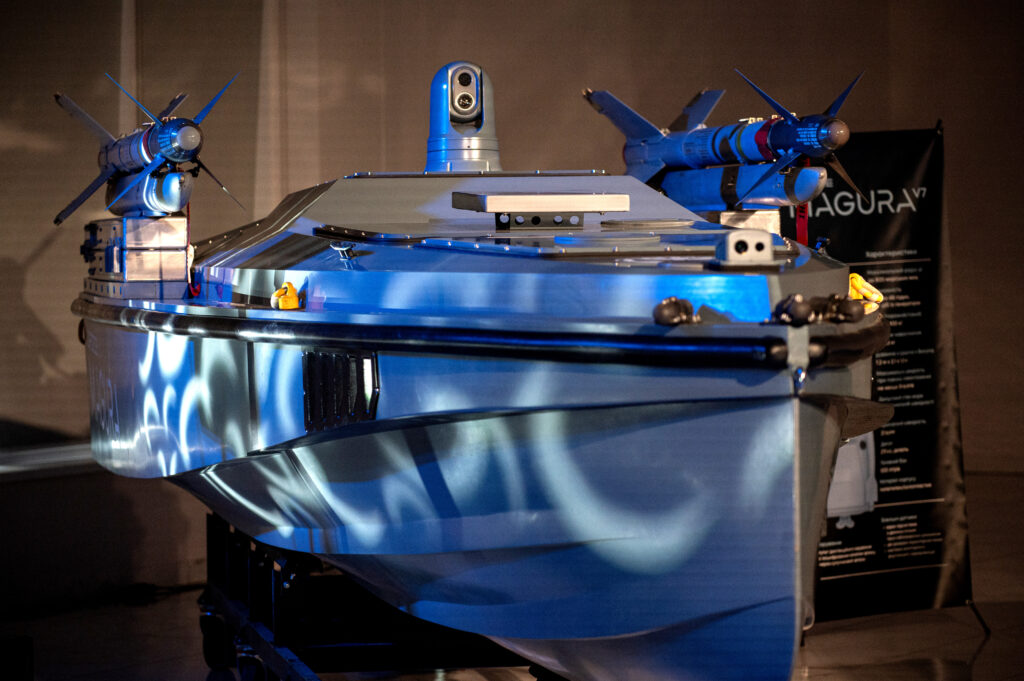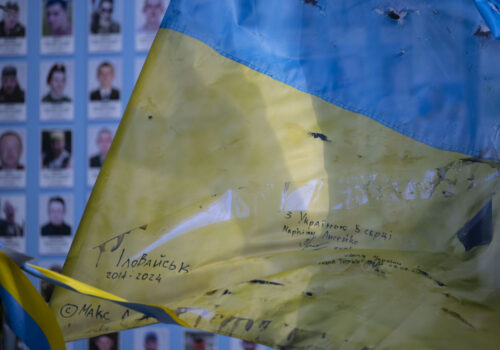Russia’s invasion of Ukraine is redefining military doctrine in ways not witnessed since the advent of air power and nuclear weapons in the first half of the twentieth century. For more than three years, both countries have been locked in a daily race to innovate that is leading to the increasing dominance of unmanned systems. This unprecedented drone war is being fought on the battlefields of Ukraine, deep inside Russia, and at sea. While Russia’s far greater resources favor Moscow, Ukraine’s sophisticated tech scene and vibrant startup culture are helping Kyiv to punch well above its weight.
Ukraine’s spectacular June 1 drone attacks on Vladimir Putin’s strategic bomber fleet at airbases across Russia made global headlines and have led to widespread claims that Kyiv has managed to “rewrite the rules of war.” However, Ukraine’s most remarkable accomplishments in the field of drone warfare have arguably been achieved thousands of miles to the south in the Black Sea.
Ukrainian Defense Intelligence Chief Kyrylo Budanov recently showcased the latest addition to the country’s expanding naval drone fleet, the Magura V7 unmanned marine vehicle. This domestically produced naval drone is armed with a pair of anti-aircraft missiles and is reportedly capable of operating at sea for days at a time while hunting Russian warplanes. According to Ukrainian officials, the Magura V7 has already proven itself in combat by shooting down two Russian Su-30 fighter jets over the Black Sea in early May. Budanov described the operation as an “historic moment.” It is believed to be the first ever instance of military jets being downed by unmanned naval platforms.
Stay updated
As the world watches the Russian invasion of Ukraine unfold, UkraineAlert delivers the best Atlantic Council expert insight and analysis on Ukraine twice a week directly to your inbox.
Last month’s destruction of two Russian warplanes was the latest in a series of remarkable maritime breakthroughs that have allowed Ukraine to gain the upper hand in the Battle of the Black Sea. When the full-scale Russian invasion of Ukraine began more than three years ago, few would have believed such a turn of events was possible. At the time, the war at sea was widely viewed as a foregone conclusion. After all, Ukraine had no conventional navy to speak of, while Russia could call on the considerable might of the country’s aged but nonetheless formidable Black Sea Fleet.
This disparity was on display during a famous incident that took place on the very first day of the invasion. On the morning of February 24, 2022, the flagship of the Russian Black Sea Fleet, the Moskva missile cruiser, loomed up to Ukraine’s Snake Island and ordered the tiny Ukrainian garrison to surrender. “Russian warship, go f*** yourself,” came the iconic response. While this message of defiance captured the global imagination and became an unofficial slogan for the entire Ukrainian war effort, the incident also served to underline the apparent mismatch between the maritime capabilities of the two adversaries.
During the initial weeks of the war, Russian control of the Black Sea remained uncontested, with Ukrainian attention focused firmly on preventing amphibious landings along the country’s southern coastline. But even at this precarious point, Ukrainian commanders had their own offensive ambitions and would soon send a powerful signal that they were capable of fighting back at sea as well as on land. In April 2022, the Ukrainian Navy launched a bold missile attack on the Moskva, securing two direct hits and sinking the Russian flagship. The attack sent shock waves around the world and sparked fury among Kremlin officials. Little did they know that this was just the first of many stunning Russian naval defeats that would transform the military situation in the Black Sea.
Eurasia Center events

Since the sinking of the Moskva, Ukraine has used a combination of domestically developed naval drones and cruise missiles provided by Kyiv’s French and British partners to decimate Russia’s Black Sea Fleet. Ukrainian Navy officials claim they have managed to damage or destroy around one-third of Putin’s entire fleet, while forcing the remaining Russian warships to retreat from occupied Crimea to the relative safety of ports in Russia itself. This has severely limited the Russian Navy’s ability to operate in the Black Sea. By spring 2024, Britain’s Defense Ministry declared that the Russian Black Sea Fleet had become “functionally inactive.”
Ukraine’s stunning success in the Battle of the Black Sea has yet to receive the international attention it deserves. By breaking the Russian naval blockade of Ukraine’s seaports, it has allowed Kyiv to resume maritime exports and secure a vital economic lifeline.
Crucially, the Russian Navy’s humiliating retreat from Crimea has also made a complete mockery of the Kremlin’s so-called red lines and has demonstrated the emptiness of Putin’s nuclear saber-rattling. The Russian dictator has long championed the seizure of Crimea as his crowning achievement, and has repeatedly hinted that he is willing to use nuclear weapons in defense of his conquests. But when confronted by the harsh military realities of Ukraine’s deadly naval drones, he withdraw the bulk of Russia’s fleet from Crimea with barely a murmur.
The Battle of the Black Sea is far from over, of course. While Ukraine develops groundbreaking new naval drones capable of hitting warplanes as well as warships, Russia continues to bombard Ukrainian seaports and targets merchant shipping carrying Ukrainian exports to global markets. The Russian Navy is also producing marine drones of its own, and is adopting defensive measures to protect the remainder of the Black Sea Fleet. Nevertheless, Kyiv’s Black Sea innovations are a reminder that Ukraine is an increasingly formidable military power in its own right and is shaping the future of drone warfare at sea as well as on land.
Peter Dickinson is editor of the Atlantic Council’s UkraineAlert service.
Further reading
The views expressed in UkraineAlert are solely those of the authors and do not necessarily reflect the views of the Atlantic Council, its staff, or its supporters.

The Eurasia Center’s mission is to enhance transatlantic cooperation in promoting stability, democratic values, and prosperity in Eurasia, from Eastern Europe and Turkey in the West to the Caucasus, Russia, and Central Asia in the East.
Follow us on social media
and support our work
Image: A Magura V7 naval drone equipped with rockets is displayed during the presentation of a series of Magura unmanned surface vehicles (USVs) by the team of the Defence Intelligence of Ukraine. (Photo by Danylo Antoniuk/Ukrinform) (Photo by Ukrinform/Ukrinform/Sipa USA)





